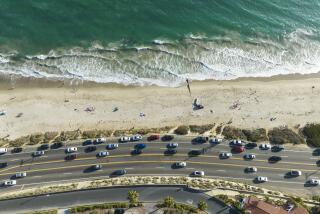O.C.’s worst sewage spill in years closes 4 miles of Laguna Beach coast
- Share via
In what is being described by Orange County health officials as the worst raw sewage spill in at least nine years, more than 500,000 gallons of effluent spewed into the street and the ocean Wednesday morning in Laguna Beach, prompting the closure of four miles of coastal waters.
Waters roughly two miles north and south of the spill, from Crescent Bay to Camel Point, near Aliso Beach, will remain closed for at least two days, authorities said.
“People can still use the beach and the sand; only the ocean is closed,” said Deanne Thompson, a spokeswoman for the Orange County Health Care Agency, which monitors ocean water quality.
County health authorities ordered the closure after being alerted about 2:30 a.m. Wednesday to flooding at a pump station near Calliope and Glenneyre streets, about a block from Coast Highway.
City crews found effluent draining onto surrounding streets and discovered the source of the spill was a 12-inch pipe that had disconnected. They worked to drain the pump station and contain the spill, channeling the waste into a storm drain that flows into Bluebird Beach. The station was back in operation by about 10 a.m.
Though several streets were closed while crews cleaned up the mess and made repairs, Coast Highway, the city’s main artery, remained open. Late Wednesday afternoon, the city announced it would hire an independent firm to investigate what went wrong.
Laguna Beach has spent more than $10 million on sewer system upgrades in recent years to prevent ruptures to its aging infrastructure, City Manager Ken Frank said.
“We have one of the oldest sewer systems in the county,” Frank said. “We have a whole lineup of repairs, including a major renovation of this particular pump station. We just didn’t get there in time.”
The health care agency is testing water at 14 locations, and coastal waters will remained closed until bacteria counts return to acceptable levels.
The unseasonably warm weather has attracted more swimmers and surfers to Laguna Beach than usual for October, so in addition to posting signs, lifeguards have had to tell dozens of people to stay out of the water, said J.J. Carvin, a lifeguard for the Laguna Beach Marine Safety Department.
“We’ve made at least 50 to 60 contacts with people who were in the water or attempting to go into the water, even with a lot of signage all over the place,” he said.
The last major spill in Orange County occurred near the same pump station in April, when 60,000 gallons of effluent flowed into the ocean after a clamp on a sewer main’s air release valve failed.
Sewage spills also shut down part of the city’s beachfront in November 2006 and in June 2005 during the Bluebird Canyon landslide.
The last major spill in Southern California took place in January 2006, when 2 million gallons of raw sewage spilled from a Manhattan Beach pumping plant after an apparent power failure. Officials launched a massive cleanup after an estimated hundreds of thousands of gallons flowed into the sand and the ocean.
The Regional Water Quality Control Board will probably ask for an investigation into Wednesday’s spill in Laguna and could fine the city if it is found to be at fault.
“More than anything else this is very unfortunate,” said John Robertus, executive officer for the board’s San Diego region. “Laguna Beach has a very old system, and they also have a lot of hills. Sewage coming down hills causes a lot of pressure.”
County health officials said increased government oversight and upgrades to sewer systems have in general helped reduce the number and size of sewage leaks over the last two decades.
But a community water quality group said the spill is proof that beach cities still need to make many improvements to protect their coasts.
“This is an exceptionally large spill, and yet it’s something that is far too common,” said Ray Hiemstra, an associate director for Orange County Coastkeeper, a Costa Mesa nonprofit that monitors water quality. “Big spills draw a lot of attention. And that’s what it takes to get the resources to make the necessary repairs.”
--
More to Read
Sign up for Essential California
The most important California stories and recommendations in your inbox every morning.
You may occasionally receive promotional content from the Los Angeles Times.











